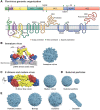A Prototype-Pathogen Approach for the Development of Flavivirus Countermeasures
- PMID: 37849402
- PMCID: PMC10582523
- DOI: 10.1093/infdis/jiad193
A Prototype-Pathogen Approach for the Development of Flavivirus Countermeasures
Abstract
Flaviviruses are a genus within the Flaviviridae family of positive-strand RNA viruses and are transmitted principally through mosquito and tick vectors. These viruses are responsible for hundreds of millions of human infections worldwide per year that result in a range of illnesses from self-limiting febrile syndromes to severe neurotropic and viscerotropic diseases and, in some cases, death. A vaccine against the prototype flavivirus, yellow fever virus, has been deployed for 85 years and is highly effective. While vaccines against some medically important flaviviruses are available, others have proven challenging to develop. The emergence and spread of flaviviruses, including dengue virus and Zika virus, demonstrate their pandemic potential. This review highlights the gaps in knowledge that need to be addressed to allow for the rapid development of vaccines against emerging flaviviruses in the future.
Keywords: antibody neutralization; antibody-dependent enhancement; arbovirus; dynamics; flavivirus; interferon; vaccine; virus-host interaction.
© The Author(s) 2023. Published by Oxford University Press on behalf of Infectious Diseases Society of America. All rights reserved. For permissions, please e-mail: journals.permissions@oup.com.
Conflict of interest statement
Potential conflicts of interest. R. J. K.’s laboratory has received funding in the form of a sponsored research agreement from Merck to examine dengue virus maturation states. A. M. D. is an unpaid consultant for Merck and Moderna; and A. M. D.’s laboratory has received funding in the form of sponsored research agreements from Takeda, Sanofi, and Moderna to evaluate dengue vaccine responses and to develop new vaccines. E. H.’s laboratory has received funding in the form of sponsored research agreements from Takeda to evaluate dengue vaccine responses. A. S. is a consultant for Gritstone Bio, Flow Pharma, Moderna, AstraZeneca, Qiagen, Fortress, Gilead, Sanofi, Merck, RiverVest, MedaCorp, Turnstone, NA Vaccine Institute, Emervax, Gerson Lehrman Group, and Guggenheim; and La Jolla Institute for Immunology has filed for patent protection for various aspects of T cell epitope and vaccine design work. M. S. D. is a consultant for Inbios, Vir Biotechnology, Senda Biosciences, Moderna, and Immunome; and M. S. D.’s laboratory has received unrelated funding support in sponsored research agreements from Vir Biotechnology, Emergent BioSolutions, Generate Biomedicines, and Moderna. All other authors report no potential conflicts. All authors have submitted the ICMJE Form for Disclosure of Potential Conflicts of Interest. Conflicts that the editors consider relevant to the content of the manuscript have been disclosed.
Figures



References
-
- Coyne CB, Lazear HM. Zika virus—reigniting the TORCH. Nat Rev Microbiol 2016; 14:707–15. - PubMed
Publication types
MeSH terms
Substances
Grants and funding
LinkOut - more resources
Full Text Sources
Medical

